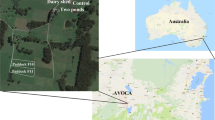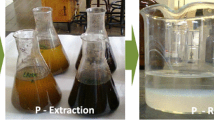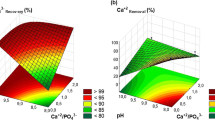Abstract
In dairy farming, recirculation and continuous use of nutrients are necessary for sustainable nutrient management in both the short- and long-term. When managed effectively, nutrient recycling can improve soil fertility. On the other hand, if applied nutrients are in excess of the soil’s nutrient holding capacity, nutrients can enter surface and ground water bodies resulting in eutrophication. Phosphorus (P) characterisation in manure, pond sludge and crust, in terms of plant availability, is the first step to sustainably manage nutrients within dairy farms. In this study, pond sludge and crust were characterised for P using a sequential fractionation method. Pond sludge and crust contained significant amounts of labile P. Water extractable P (H2O-P) in primary anaerobic pond and secondary facultative pond sludges was found to be about 8 to 13 times higher than the amount found in the surface soil (0–10 cm) of a grazing paddock. Similarly, sodium bicarbonate extractable P (NaHCO3-P) in the two types of sludges was found to be about 6 times higher than in the soil. The relatively higher labile P (H2O-P and NaHCO3-P) in sludge compared to soil indicates that the sludge can be utilised as a P fertilizer on grazing pasture. In contrast, lower H2O-P compared to that of raw manure indicates that the use of sludge and crust instead of raw manure can reduce the possibility of P loss by surface runoff and leaching. Hence, it is preferable to use pond sludge and crust as fertiliser instead of raw manure.





Similar content being viewed by others
References
Cade-Menun, B. J., He, Z., & Dou, Z. (2015). Comparison of phosphorus forms in three extracts of dairy feces by solution 31 P NMR analysis. Communications in Soil Science and Plant Analysis, 1–15. https://doi.org/10.1080/00103624.2015.1047512.
Cameron, K. C., Rate, A. W., Noonan, M. J., Moore, S., Smith, N. P., & Kerr, L. E. (1996). Lysimeter study of the fate of nutrients following subsurface injection and surface application of dairy pond sludge to pasture. Agriculture, Ecosystems & Environment, 58(2–3), 187–197.
Cross, A. F., & Schlesinger, W. H. (1995). A literature review and evaluation of the. Hedley fractionation: Applications to the biogeochemical cycle of soil phosphorus in natural ecosystems. Geoderma, 64(3), 197–214. https://doi.org/10.1016/0016-7061(94)00023-4.
Dairy Australia. (2017). Dairy situation and outlook. Southbank: Dairy Australia Limited.
Dao, T. H., Lugo-Ospina, A., Reeves, J. B., & Zhang, H. (2006). Wastewater chemistry and fractionation of bioactive phosphorus in dairy manure. Communications in Soil Science and Plant Analysis, 37(7–8), 907–924. https://doi.org/10.1080/00103620600588637.
Dou, Z., Toth, J. D., Galligan, D. T., Ramberg Jr., C. F., & Ferguson, D. J. (2000). Laboratory procedures for characterizing manure phosphorus. Journal of Environmental Quality, 29, 508–514.
Fyfe, J. (2014). Characterisation, monitoring and dynamic modelling of a two-stage stabilisation pond system supporting reuse and recycling of dairy shed effluent. Doctor of Philosophy thesis, University of Wolongong, Wollongong, Australia.
Fyfe, J., Hagare, D., & Sivakumar, M. (2016). Dairy shed effluent treatment and recycling: effluent characteristics and performance. Journal of Environmental Management, 180, 133–146. https://doi.org/10.1016/j.jenvman.2016.04.058.
Gourley, C. J. P., Aarons, S. R., Hannah, M. C., Awty, I. M., Dougherty, W. J., & Burkitt, L. L. (2015). Soil phosphorus, potassium and sulphur excesses, regularities and heterogeneity in grazing-based dairy farms. Agriculture, Ecosystems and Environment, 201, 70–82.
He, Z., & Honeycutt, C. W. (2001). Enzymatic characterization of organic phosphorus in animal manure. Journal of Environmental Quality, 30(5), 1685–1692.
He, Z., Honeycutt, C. W., Toor, G. S., & Sims, J. T. (2006). An enzymatic hydrolysis approach for characterizing labile phosphorus forms in dairy manure under mild assay conditions. Soil Bioresource Technology, 97(14), 1660–1668. https://doi.org/10.1016/j.biortech.2005.07.021.
He, Z., Honeycutt, C., Cade-Menun, B., Senwo, Z., & Tazisong, I. (2008). Phosphorus in poultry litter and soil: enzymatic and nuclear magnetic resonance characterization. Soil Science Society of America Journal, 72(5), 1425–1425.
He, Z., Honeycutt, C. W., Zhang, H., Toor, G. S., Dou, Z., Haggard, B. E., & Reiter, M. S. (2010). Phosphorus distribution in sequentially extracted fractions of biosolids, poultry litter, and granulated products. Soil Science, 175(4), 154–161. https://doi.org/10.1097/SS.0b013e3181dae29e.
He, Z. (2013). Environmental Chemistry of Animal Manure. New York: Nova Science Publishers Inc.
Hedley, M. J., Stewart, J. W. B. & Chauhan, B. (1982). Changes in inorganic and organic soil phosphorus fractions induced by cultivation practices and by laboratory incubations 1. Soil Science Society of America Journal, 46(5), 970–976.
Houlbrooke, D. J., Horne, D. J., Hedley, M. J., & Hanly, J. A. (2004). A review of literature on the land treatment of farm-dairy effluent in New Zealand and its impact on water quality. New Zeal. J. Agr. Res., 47, 499–511 0028-8233/04/4704-0499.
Jacobs, J. L., & Ward, G. N. (2007). Effect of second pond effluent applied in spring to silage regrowth of perennial ryegrass based pasture in southern Australia. 2. Changes in nutritive characteristics and mineral content. Australian Journal of Agricultural Research, 58, 145–151.
Jacobs, J. L., & Ward, G. N. (2008). Effluent and nitrogen fertiliser effects on dry matter yield nutritive characteristics and mineral and nitrate content of turnips. Crop & Pasture Science, 59, 624–631.
McDowell, R., Nash, D., & Robertson, F. (2007). Sources of phosphorus lost from a grazed pasture receiving simulated rainfall. Journal of Environmental Quality, 36(5), 1281–1288.
Monaghan, R. M., Hedley, M. J., Di, H. J., McDowell, R. W., Cameron, K. C., & Ledgard, S. F. (2007). Nutrient management in New Zealand pastures— recent developments and future issues. New Zealand Journal of Agricultural Research, 50(2), 181–201. https://doi.org/10.1080/00288230709510290.
Pettygrove, G., Heinrich, A., & Eagle, A. (2010). Dairy manure nutrient content and forms. Manure technical guide series. Davis: University of California Cooperative Extension.
Rayment, G. E. (2011). Soil chemical methods. Australasia: CSIRO Publishing.
Rice, E., Bridgewater, L., & American Public Health Association & Water Environment Federation. (2012). Standard methods for the examination of water and wastewater. Prepared and published jointly by American Public Health Association, American Water Works Association, Water Environment Federation. ed.). Washington, D.C.
Sharpley, A., & Moyer, B. (2000). Phosphorus forms in manure and compost and their release during simulated rainfall. Journal of Environmental Quality, 29(5), 1462.
Turner, B., & Leytem, A. B. (2004). Phosphorus compounds in sequential extracts of animal manures: chemical speciation and a novel fractionation procedure. Environmental Science & Technology, 38(22), 6101–6108. https://doi.org/10.1021/es0493042.
Ward, G., & Jacobs, J. (2008a) Effectiveness of dairy first pond sludge as a nutrient source for forage crop production. Paper presented at the Australian Agronomy Conference, Adelaide.
Ward, G., & Jacobs, J. (2008b). Effectiveness of dairy first pond sludge as a nutrient source for perennial ryegrass pasture production. Paper presented at the Australian Agronomy Conference, Adelaide.
Acknowledgements
The authors wish to acknowledge Mr. Gregory Schofield of Schofield Holsteins for his continuous support and also technical staff and students of Environmental Engineering Lab.
Funding
This study was carried out with the support of School of Computing, Engineering and Mathematics (SCEM), Western Sydney University.
Author information
Authors and Affiliations
Corresponding author
Rights and permissions
About this article
Cite this article
Hong, W.T., Hagare, D., Khan, M. et al. Phosphorus Characterisation of Sludge and Crust Produced by Stabilisation Ponds in a Dairy Manure Management System. Water Air Soil Pollut 229, 276 (2018). https://doi.org/10.1007/s11270-018-3912-0
Received:
Accepted:
Published:
DOI: https://doi.org/10.1007/s11270-018-3912-0




